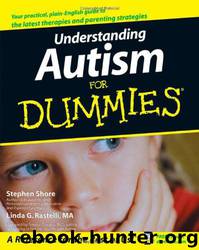Understanding Autism for Dummies by Stephen Shore & Linda G. Rastelli

Author:Stephen Shore & Linda G. Rastelli [Shore, Stephen & Rastelli, Linda G.]
Language: eng
Format: epub
Tags: General, Health & Fitness
ISBN: 9781118053133
Publisher: John Wiley & Sons
Published: 2011-03-01T08:20:26+00:00
17_525476 ch10.qxp 8/2/06 3:23 PM Page 190
190 Part III: Enhancing Learning and Social Skills
Building schedules can assist with expressive communication when the child has the opportunity to help put the schedule together. Working with a schedule can also help with receptive communication (when the time comes to change from one activity to another, for example).
Developed by Pyramid Educational Consultants, the Picture Exchange Communication System (PECS; see Figure 10-1) is a database of over 3,000
graphics that can help a nonverbal person with his or her receptive and expressive communication efforts. PECS works with children, adolescents, and adults who have communicative, cognitive, and physical difficulties. The PECS isn’t just a visual support; it involves using a specific protocol (which is explained in the PECS Training Manual, 2nd Edition, written by Lori Frost, MS, CCC/SLP, and Andrew Bondy, PhD).
In the first phase of PECS, the person learns to initiate communication by requesting an item. Later phases involve making sentences and responding to questions. Although language isn’t necessary in PECS, it often develops through the use of PECS.
For information on purchasing the PECS, you can go to Pyramid’s Web site at www.pecs.com.
Figure 10-1:
A visual
system,
such as a
Picture
Exchange
Communica-
tion System,
makes
communica-
tion easier
for a visual
learner.
Another program, Writing with Symbols 2000 (available at www.widgit.com/
products/wws2000/index.htm), serves as a bridge between graphically 17_525476 ch10.qxp 8/2/06 3:23 PM Page 191
Chapter 10: Dealing with Learning and Sensory Differences 191
based and text-based communication. Graphics from Mayer-Johnson and Widgit Rebus symbols appear together with words so that a person who understands only graphics can choose what he or she wants to communicate with the words appearing under the graphics. Text-based people can type out text, and the program will include the accompanying graphic.
Medium-technology assistance
Medium technology includes simple electronic devices such as tape recorders, overhead projectors, timers, calculators, and voice output machines. One such device, the Language Master, uses 3 x 8-inch cards with recordable magnetic strips for short verbal messages; you can place pictures and other cues on the cards. Another device, the Talk Pad, has four large buttons on which you can attach pictures, symbols, or other cues to represent the verbal message generated when the button is pushed. Other output devices such as the Voice in the Box and the Step by Step Communicator work in similar ways.
Unlike the low-tech devices, medium-tech items are often less adaptable and more cumbersome. However, they may be more effective in filling a specific need of the individual in a limited number of settings or situations.
Some uses for medium-tech devices include:
ߜ Enhancing expressive vocal communication through Voice Output Communication Aids (VOCAs) that produce synthetic or digitized speech output when activated by individuals
ߜ Attending (focusing on the task at hand) and organization ߜ Sequencing (putting things in order) and phonics
Boardmaker, a software program available for both Mac- and Windows-based computers, uses PECS (see the previous section) and other graphics for developing communication strips, schedules, calendars, and other materials for communication. You can use the graphics in conjunction with assistive communication devices such as DynaVox and the Language Master.
DynaVox is
Download
This site does not store any files on its server. We only index and link to content provided by other sites. Please contact the content providers to delete copyright contents if any and email us, we'll remove relevant links or contents immediately.
Teach Your Child How to Think by Edward De Bono(2143)
Little Soldiers by Lenora Chu(1338)
NLP For Parents by Judy Bartkowiak(1253)
The Book of Virtues by William J. Bennett(1162)
Dotcom Secrets by Russell Brunson(1116)
Happy Is the Bride by Lori Wilde(1066)
Lost at School by Ross W. Greene(1066)
The Homeschooling Handbook by Mary Griffith(1018)
The Enlightened College Applicant by Andrew Belasco & Dave Bergman(1018)
What to Expect the First Year by Heidi Murkoff(1009)
The Book of Ruby(991)
LESSONS_IN_LOVE by Administrator(989)
The Physics Book by DK(958)
The Gift of Failure by Jessica Lahey(957)
Living Out Loud by Anna Quindlen(955)
The New Sex Bible by Jessica O'Reilly(948)
Math with Bad Drawings: Illuminating the Ideas That Shape Our Reality by Ben Orlin(944)
Weapons of Mass Instruction by John Taylor Gatto(917)
The Most Important Year by Suzanne Bouffard(889)
